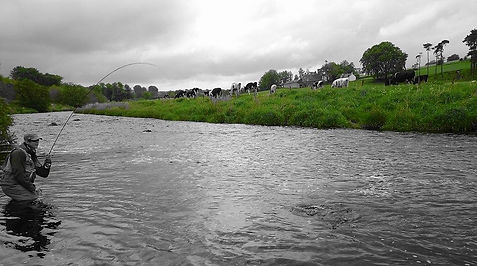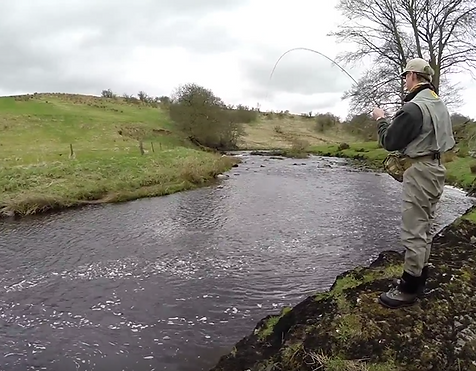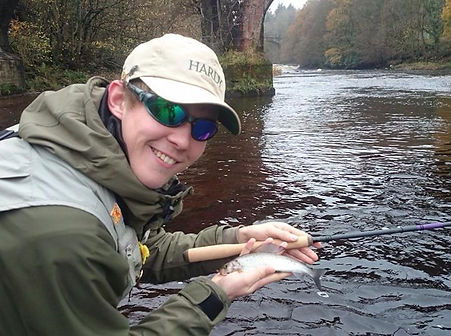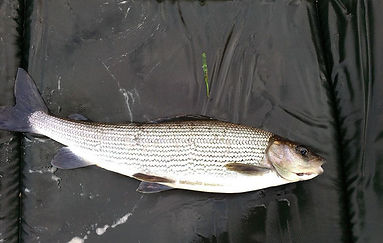
Methodology
This area of the website is the go-to-place for deadly techniques and how to approach the River in any season or situation
Fly Fishing
Fly fishing is a sport where you try to fool a fish into taking an artificially tied fly to imitate the natural food items it preys on. This fly must be presented as naturally as possible- Especially in a river or stream where drag from the current is present, fish will often refuse a fly fished unnaturally dragging in the current.
Fly Fishing consists of various techniques based upon where you fish, what species of fish you are targeting and what time of year you are fishing. Fly fishing is orientated around the seasons.
Fly fishing is centred around the seasons and the fly's or nymphs expected to hatch within the given time period.
i.e in Ireland there are mass hatches of mayfly's- Anglers travel from all around the world to arrive on time for the prolific may fly hatches where fish readily feed on the seasonal flies.


When approaching the river, try not to cast your shadow onto the water- this will often spook fish( especially clear water)
•Keep a low profile when approaching a wary fish- use features like bankside vegetation to camouflage yourself into the surroundings.
•Do not wade any deeper than you need to, fish will hug the bank in their preffered lies or sit at only two rods lengths away from the bank.
•It is good to rest a pool after fishing it extensively, fish do not feed as confidentially when the water has been disturbed by angling pressure.
•Do not cast any more strokes than you need to( especially at close quarters) Depending on casting ability; two/three false casts usually gets the fly in the zone of feeding fish, anymore and this might result in a spooked fish.
• if possible- present the fly at least 5-6 foot away from the fish. This gives time for the fish to identify the fly. Giving it more time to take, but also giving it more time to nit-pick preferences of fly i.e is it emerging, does it have a broken wing
River Craft
Czech/French Style Nymphing
The aim of the game is to fish casting no longer than two rods lengths away from you- thus allowing greater control and feel of the flies.
Flies will be heavy; follow the general rule of thumb- lightest fly on top dropper tapering down to heaviest fly at the point.Cast flies directly just upstream of you at an 11 o'clock angle and keep in touch with them using a figure of eight or a slow, steady retrieve, dependant on the speed of the current, to combat drift- make upstream mends when required.
Fishing at an 11 o’clock angle and slowly swinging the flies round until they meet three o’clock, a slow figure of eight keeps in contact with flies fished at the speed of the current. To overcome drag from current- make an upstream mend.At end of drift- Dabble fly's and then prepare for next cast…
Fly Fishing during november-february
During this period fishing is strictly subject to and only Grayling fishing. Techniques such as heavy Czech style nymphing or French indicator nymphing can prove incredibly rewarding.
•On bigger rivers, using a 10ft 4/5 weight rod, a short length of sinking line (2ft-3ft) attached to the main line can get the fly down to where the fish are lying.
•The 10ft 4/5 weight rod will give you better reach to keep flies under control, the light weight action will allow you to cast continuously without tiring and still allows for a sensitive touch with flies. It Also has enough back bone should a big fish take.
• shorter rods can still be used, performing just as well but just lacking reach. similar to the line setup, a hover fly line or midge tip can also perform as effectively.
•Grayling are most active during this period, if irregularly warm, take a small selection of emerger dry's as grayling can readily take in this way.
•The opportune ‘Klink and dink’ method is a perfect option for rising fish as it gives two options- a dry, and a nymph( preferably unweighted) just below it.
Seasonal Fishing
Fly Fishing March- April ( Wet Fly)
•Flies may consist of;spiders, various un-weighted and weighted nymphs, emergers, dry flies. i.e upwing and roof winged flies-olive uprights ,march brown,duns , grannom sedge.
• when fishing nymphs have a minimum dropper spacing of around 2-3 feet dependant upon your casting ability. I reccomend two droppers 2-3 feet apart, if conditions are reasonably warm and depending on hatch life I personally suggest an individual uses wet flies such as water hen bloas if there are few olive uprights coming off.
Apply the same principal of matching the hatch, grub around with a small net along the bankside, at this time of year you will find many nymphs still to hatch along with hydropsyche and gamarus( freshwater shrimp)
if their are no hatches and conditions are bitter I recommend a cast of weighted and unweighted nymphs like the hares ear, polyfitus nymph, spider nymphs, pheasant tails.
•Fish only one dropper in bad wind conditions- 3-4 feet apart from point fly( heavy goldhead/ weighted nymph)
Fly Fishing May-July( Dry Fly)
•At this stage of the year, most of the action is taking place on or near the surface layers.
•Look for calmer stretches on the river or stream. Fish beside features such as trees- not too close! trees break the wind, food items will remain undisturbed by the wind lanes. Trout will often hold in these areas- sipping in the spent, emerging or egg laying flies.
•The wind will also blow terrestrial fly's onto the water- daddy's, hawthorns, ants, heatherfly etc…
•During this part of the season, fish feed incredibly selectively, making the job frustrating and creating new challenges. Some times, fish will only feed on fly's with broken wings or flies who are already spent.In order to fool these fish- gink only half of the fly to achieve a subsurface presentation, thus making the artificial look spent.
•Your cast should consist of emerger and dry patterns, small F flys, quilled olives, spinners, duns of various size and colour, the may fly in its forms.
•Carry terrestrial imitations just in case of a behavioural feeding change- terrestrial flies will often be blown onto the water as a result of the wind blowing against the trees or bankside vegetation
Dont be phased by selective 'picky' feeders, if you carry different sizes and colours of a certain pattern that resembles the targeted flies, you should be fine
During this time, patterns look more imitative and are generally fished in the upper layers of the water.
•Look for features- i.e over hanging branches, fish will lie under here as they feel more protected from predators, thus making them more likely to take confidentially.
• large boulders breaking current- fish will often lie in behind these boulders when water is slightly pacier , when an item of food passes, they have little time to think about target points to look for, so will take aggressively.
•Shallows-fish will use the shallows like food conveyer belts, picking off a tasty morsel, they have more time to look for key features so patterns should look and be fished as realistically as possible. Here, an abundance of nymphs and shrimps will thrive
• ledges- fish will peruse and grub for nymphs and ambush small pin fry. Note- Fish will tend to lie in these areas
Tactics for August-October
•Fishing during the harvest (for me personally) is all about imitative patterns i.e realistic fly patterns such as fry patterns e.g minnows.. At this time of year trout whether it be Loch, stream, river or fishery- trout will be hammering into fry; fattening themselves up for winter consuming as much as they can;Ambushing small bait fish against structure: dam walls or pushing them up into the shallows. On the other end of the spectrum - Terrestial flies such as daddy long legs, black gnats, heather fly etc- it’s a good time to use such flies as the summers hatches are behind us( not to say there wont be a hatch) but not as prolific. Terrestrials( after all these flies do not have a season, and are land born) not like e.g the may flies and specific duns. They are a stable source of food for trout all year round . However,harvest time is famous for the daddy long legs, they will bring trout right up in the water- fish will gorge themselves on the
protein rich flies.
Streamer Fishing
This Technique can be used anually when brown trout are in season.Streamer fishing is a very effective technique for river, stream and burn fishing. Trout will feed on fry i,e minnows, pin fry and other smal fishes. It is a rewarding technique to use as you will often be selecting the larger more canabalistic trout which grow larger and faster due to the protein rich fish diet. you can use rods between 9-10 ft being 4-6 weight matched withfloating lines but when river is running high yet clear I recommend a 9ft -10 foot 5/6 # partnered with a slow glass intermediate fly line with a leader around the same as the rod( Also check the rules and regualtions of the water if you can use a non-toxic split shot on your tippet) I find it gets the fly down quicker to the depth of the fish and it gives an alluring jigging action on the retrieve.
Spinner/ Bait fishing
Occasionally we will bait fish or spin if river conditons do not allow for effective fly fishing.
Split shot lining-
A superb method for use over gravel beds or featureless river bottom. the setup consists of various weighted non-toxic shots tapering down to a hook link of roughly 2-3 feet.
long trotting ( Grayling)
A very effective method we exersise in winter, I personally use a 13 foot Avon trotting rod with a centrepin reel( main line- 6lb BS), A sliding float on rubbers runs down to bulk shot and then followed by a tiny size 16-18 hook fished with 2-3 white maggots with a red maggot or pinkie to act as an attractor.
Spinning
A technique often frowned upon, but if you know what your doing and you hook fish properly and handle them with care it can be a very effective method for carnivourous trout in high or low water
I recommend the use of a small size 0 mepp with hints or spots of red on the spinner blade, but the ordinary gold silver and bronze blades are just as good.







Tenkara Fishing
Tenkara Fishing is the oldest known art of fly-fishing known to man. It was discovered by the expert Japanese mountain stream anglers over 200 years ago.It is a simplistic and minimalistic form of fly-fishing and only requires- a rod, tenkara line and a fly.Unlike western fly fishing, tenkara fly-fishing only uses a fixed line for casting; no reel is required. Rods range in lengths from 11 feet to 14 feet, the long rod allows precice control over the flies drift, thus making it an exeptionally effective technique where delicate presentation is required. Tenakara fly-fishing is perfectly adapted to fishing in fast small streams and rivers throughout the world
Safe Handling of Fish
It is important to handle fish appropriately after tiring them out, this is where they are most vulnerable. Minimising stress to the fish is of the utmost importance to ensure that the fish is returned safely.
If you want a picture with the fish, have your friend set-up the camera in time so as not to time-waste by keeping the fish out of the water. Always keep the fish low to the water or over the net, so if the fish falls it will be cushioned by the fish-friendly net or the water.
If you feel the fish is a specimen and you want to weigh it- wet a bass bag or carrier bag to prevent the removal of the protective slime of the fish.
The Release
When releasing the fish, hold it in medium-paced water where there is suffient oxygen being circulated over the gills. Face the fish naturally upstream and hold with a light,supportive grip between the pectoral fin and anal fin. When you feel the fish kicking off let it slip through yor hands or over the rim of the net.
video demonstration shown adjacent-
Tenkara Fly-Fishing informational and instructional video.
By Josh Maitland
Czech Nymphing informational video by Josh Maitland
A guide to maintaining your fly-line and fly-rod by Josh Maitland
Safe handling of fish for Catch and Release

Cleaning solutions you will need:
~ Fairy liquid( why not try a mixture as shown in demo
~ Silicone spray or dash board cleaner
~ One soft cloth
~ 2 every day dish sponges
Preference/ Additional Solutions :
~ Fishing brand line up or line slick solution
( strongly advise Loon outdoors line speed)

To an extent, you could use an unhooking mat when fish, much like Grayling-have a tendancy to jump and twist in your hands. Make sure the mat is saturated and always wet your hands! Keep the fish low to the mat; supporting it behind the pectoral fins and anal fin. This hold is the best for the fish as it supports its delicate body without causing stress or damage to its internal environment. This can be used for a quick picture. fish must NOT be kept out water for longer than 30-45 seconds.


The study of 'Reading a Rise'- Through fishing experiences and by reading books like ' Secrets of Fly-Fishing for Trout' by Ian Ball, I am now confident in my ability to identify what trout feed on throughout the seasons- its not rocket science!
Surface- Breaking (splashy) rise
If a Trout's rise is splashy, it will be hitting and drowning a fly, or they may actually be airborne chasing flies which are darting on or near the surface. Such flies will generally be large like mayflies, caddis, stone flies, crane flies and dragon flies- especially if the rise is explosive There are a whole host of flies that fit the bill.
Tip-Locate flies by brushing your hands or legs through the bankside brush, or get down to a low profile watching the river intently and wait for flies to pass by. I use binoculars to determine what a trout is taking.
Standard Surface (nosing) rise
Watch the Trouts's rise form carefully, if you see its nose or head breaking the water surface with a light riple of rings it will be feeding on the surface for water born insects- bursting from their nymphal shuck or flies that are caught in the surface film. The expected flies will be duns and mayfly's.
Lethargic (sipping) rise
If you can see the trout opening its mouth and 'sucking in water', this is a tell-tale sign that it is feeding on emerging flies, nymphs and pupae- floating just below the water surface waiting to hatch.
Head & Tail (dipping) rise
Watch out for the heart stopping head and tail rise. These fish will be rolling over flies effortlessly and gracefully, feeding just slightly below the surface on nymphs and pupae- such as buzzers. Use diawl bachs, buzzer patterns and unweighted nymphs in this circumstance.
Sub Surface Boil (whirling) rise
The water will be disturbed 'nervous water' and appears whirl like. Feeding occurs 18 inches to 5 feet below the surface. Fish will be feeding on ascending nymphs and pupae.
Bow Waving (torpedo)
This form of feeding will be explosive and torpedo like. Trout will be hammering into fry, coralling and pinning them to the surface,smashing them into the dam walls or banks. Use fry patterns and small lures that resemble silver bait fish- like minnows and glass pin fry.



'Reading' the Rise





